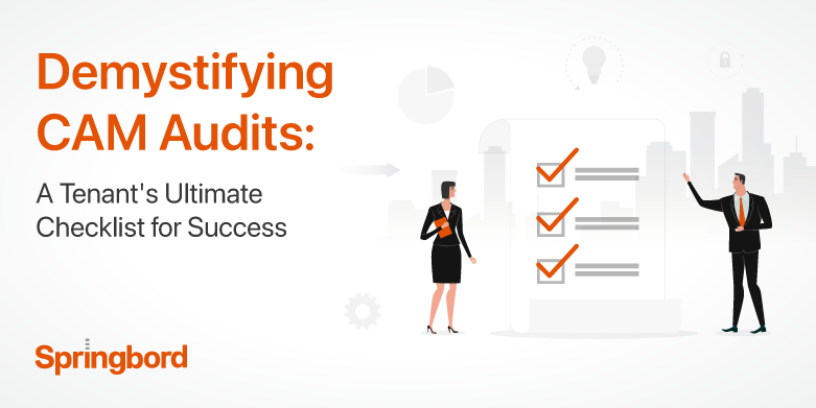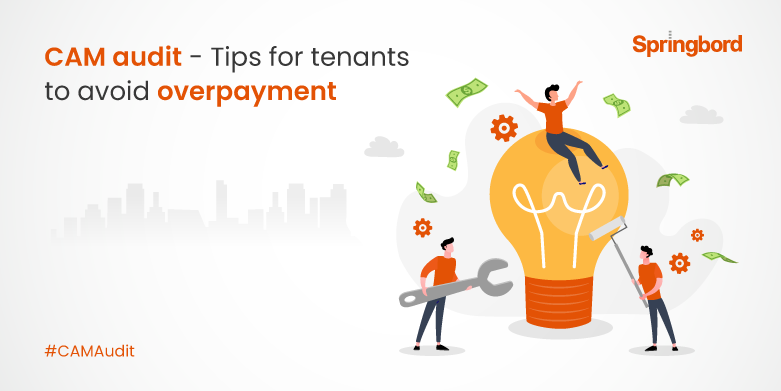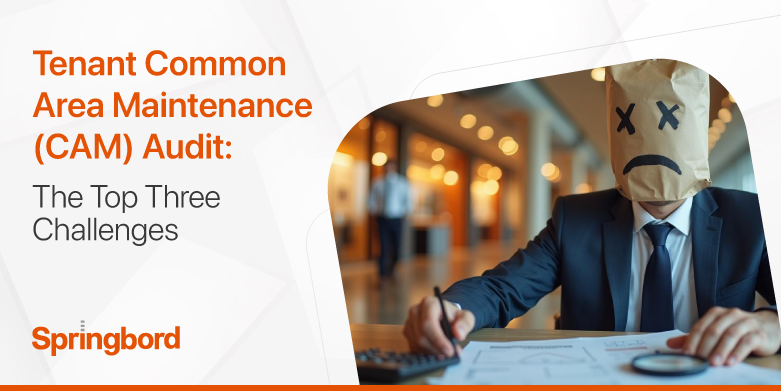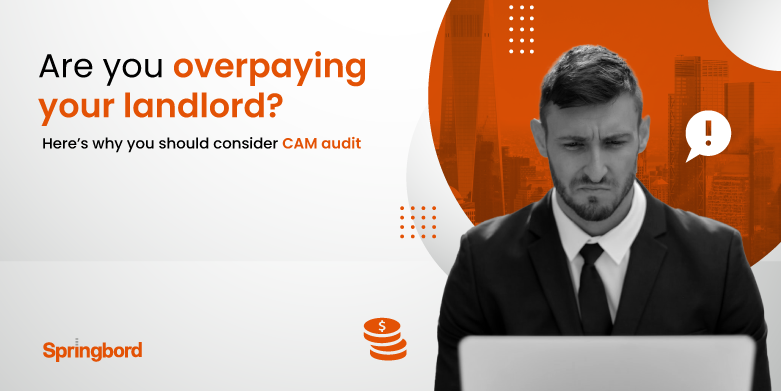 Read time 5 min
Read time 5 minNavigating the complexities of Common Area Maintenance (CAM) charges in commercial real estate can be a daunting task for tenants. With varying factors like square footage, types of tenants, and fluctuating maintenance costs, it’s vital for businesses to ensure they are being billed fairly. This is where a thorough understanding of CAM audits becomes indispensable. A CAM audit not only ensures transparency in billing but also helps tenants avoid unnecessary expenses.
As we delve deeper into the key components of CAM audits, the significance of such services, including those offered by Springbord, becomes increasingly clear. Whether it’s understanding the impact of anchor tenants, accurately calculating the Pro Rata Share (PRS), ensuring compliance with caps on increases, or aligning actual costs with budgets and estimates, a professional CAM audit can make a substantial difference in managing commercial real estate expenses.
Now, let’s explore the key components of CAM audits to gain a clearer understanding of what tenants should be vigilant about to ensure fairness and accuracy in their CAM charges.
The Necessity of Audits
CAM audits are vital for tenants to ensure that the charges they are paying are accurate and justified. Issues in CAM calculations can include overcharges, incorrect allocation of expenses, or non-compliance with lease terms. For example, a study by Jones Lang LaSalle found that discrepancies in CAM charges can lead to tenants overpaying by up to 3% annually.
Key Components of CAM Audits
1. Examining Anchor Tenants
Anchor tenants are major tenants in a commercial property, often occupying large spaces and drawing significant customer traffic. Their lease terms can significantly influence CAM charges for other tenants. Understanding the role and impact of anchor tenants is crucial for a fair allocation of CAM charges.
A report by Colliers International suggests that anchor tenants can account for up to 50% of a mall’s retail space but may negotiate to pay a disproportionately lower share of CAM charges.
The formula for calculating each tenant’s share of CAM charges, considering anchor tenants, could be represented as:
Non-Anchor Tenant’s CAM Charge =
Total CAM Costs * (Tenant’s Leased Square Footage
——————————————–
Total Leasable Square Footage−Anchor Tenant’s Leased Square Footage)
Example: If a mall has 100,000 sq ft of leasable space, with an anchor tenant occupying 40,000 sq ft, and the total CAM costs are $200,000, a non-anchor tenant occupying 10,000 sq ft would pay:
CAM Charge= $200,000×(10,000
—-———- =$33,333
100,000−40,000)
2. Pro Rata Share (PRS) Calculations
PRS calculations are used to determine each tenant’s share of CAM costs based on their proportion of the total leasable area. Accurate square footage measurement is essential for fair CAM charges.
According to a BOMA International report, errors in square footage calculations can lead to a 5-10% discrepancy in CAM charges.
The PRS formula is:
Tenant’s PRS = (Total Leasable Square Footage of the Property
————————————————————- ×Total CAM Costs
Tenant’s Leased Square Footage)
Example: For a tenant leasing 5,000 sq ft in a building with 50,000 sq ft and total CAM costs of $100,000, the PRS is:
Tenant’s PRS=(50,000
——— ×$100,000 = $10,000
5,000)
3. Caps on Increases
Caps on CAM charge increases are stipulations in leases that limit the annual increase in CAM charges. This is crucial for budgeting and financial planning for tenants.
A study by Jones Lang LaSalle indicates that without caps, CAM increases can exceed the rate of inflation, sometimes growing by more than 5% per year.
Example: If a lease stipulates a 3% annual cap on CAM increases, and the initial CAM charge is $10,000, the maximum CAM charge for the following year can only be $10,300.
4. Compliance with Budgets and Estimates
This involves comparing the actual CAM expenses incurred by the landlord with the estimated or budgeted amounts. Discrepancies can indicate either overestimation or underestimation of costs.
Research from CBRE shows that variances between actual and budgeted CAM costs are common, often ranging between 2-5%.
Example: If the budgeted CAM cost is $100,000 but the actual cost incurred is $105,000, this 5% variance should be scrutinized and justified by the landlord.
Navigating CAM Audits
Inclusions and Exclusions in CAM Charges
Typical inclusions in CAM charges are maintenance, security, and utilities. However, tenants must be alert for exclusions. Capital improvements, for instance, should not be typically included in CAM charges. Data from a BOMA International study reveals that approximately 30% of CAM disputes arise from incorrect inclusions. Springbord’s CAM audit services can help tenants discern these inclusions and exclusions, safeguarding against unfair charges.
Addressing Double Billings
Double billing is a common error in CAM charges. A survey by Colliers International suggests that around 20% of tenants encounter double billing in their CAM statements at some point. Identifying and rectifying these requires careful examination of CAM statements.
Lease Agreement Clauses
Lease clauses related to CAM are crucial. Research indicates that tenants with clearly defined CAM clauses in their leases are 40% less likely to face overcharges, as per a report by Jones Lang LaSalle. Seeking assistance from specialized services like Springbord can ensure that tenants negotiate favorable terms in their lease agreements.
Best Practices for Tenants
Regular Monitoring
Regular monitoring of CAM charges is essential. A study by CBRE found that tenants who regularly review their CAM statements can detect and resolve discrepancies 50% faster than those who do not. This vigilance is crucial for early detection of errors.
Professional Assistance
The complexity of commercial leases often necessitates professional guidance. According to Deloitte, tenants who utilize professional services for CAM audits save an average of 15-20% on their CAM charges. Expertise from firms like Springbord can be crucial in complex lease structures or significant discrepancies.
Documentation and Record-Keeping
Effective record-keeping is vital in CAM audits. Research by KPMG indicates that proper documentation can expedite dispute resolution by up to 70%. Keeping comprehensive records, including all relevant documents for at least the duration of the lease plus a few additional years, is recommended. Services provided by Springbord can assist in the systematic organization and maintenance of these crucial documents.
End Notes
In conclusion, navigating CAM charges in commercial real estate requires diligence, knowledge, and sometimes professional assistance. CAM audits play a pivotal role in ensuring transparency and fairness in these charges. Key aspects such as understanding the impact of anchor tenants, accurately calculating Pro Rata Share, adhering to caps on increases, and aligning actual costs with budgets are essential for tenants to avoid overpaying. Regular monitoring, understanding lease agreement clauses, and addressing issues like double billings are critical practices for tenants.
Springbord can provide invaluable assistance in these complex processes. With expertise in areas like documentation, lease negotiation, and detailed audit services, tenants can potentially save a significant percentage on their CAM charges.
In essence, a proactive approach to CAM audits, equipped with the right knowledge and resources, is the ultimate checklist for success for tenants in commercial real estate.
Contact us today to learn how Springbord can help you navigate CAM charges effectively and ensure you’re not overpaying.







